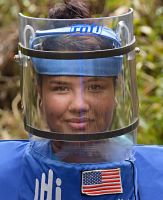share

Jennifer Diaz works as a deminer near Vistahermosa, Colombia. | © Till Mayer / HI
Five years after the end of the Colombian civil armed conflict, tens of thousands of landmines are still threatening people's lives. More and more women are taking on the task of removing them.
 Colombia is one of the countries most contaminated by mines in the world, with 28 out of 32 departments contaminated by mines and almost 12,000 victims of landmines in 25 years. 25-year-old Jennifer Diaz Gonzalez has been working as a deminer at HI since 2017. She is working to de-mine the region of Vistahermosa, Meta, the department where she grew up and still lives with her young daughter. “The whole region was under control by a guerrilla organization”, says Jennifer. Her father was murdered by an illegal armed group when she was only 1 year old, and her two older brothers were forcibly recruited to fight as teenagers. "They have disappeared since then. And there is no hope of seeing them alive again,” says Jennifer.
Colombia is one of the countries most contaminated by mines in the world, with 28 out of 32 departments contaminated by mines and almost 12,000 victims of landmines in 25 years. 25-year-old Jennifer Diaz Gonzalez has been working as a deminer at HI since 2017. She is working to de-mine the region of Vistahermosa, Meta, the department where she grew up and still lives with her young daughter. “The whole region was under control by a guerrilla organization”, says Jennifer. Her father was murdered by an illegal armed group when she was only 1 year old, and her two older brothers were forcibly recruited to fight as teenagers. "They have disappeared since then. And there is no hope of seeing them alive again,” says Jennifer.
She explains that it is very difficult to find the landmines. "Most of the mines we find are self-made explosive devices,” hidden in the areas surrounding Vistahermosa. Jennifer and her team have to scan about 11,000 m² within six months. Jennifer is very much aware of the constant danger of her job. It requires the utmost concentration. First, she must find the explosive device and carefully uncover it. She then marks it and makes it visible to others, with a sign for example. Finally, the explosive device is either defused or detonated.
Jennifer knows that demining is the key to a safe life in Vistahermosa. Only when HI’s specialists declare a region safe can farmers use the fields or children play and walk safely on the paths. The young woman takes pride in her job, "The local people have great respect for our work."
“We will make sure that the mines disappear so that farmers can grow coffee and keep livestock without danger. That is something very beautiful," says Jennifer Diaz Gonzalez.
In Vistahermosa, HI has been running a humanitarian civilian demining project since November 2016. This village has the highest number of landmine victims in Colombia. Lockdown periods, imposed by the COVID-19 pandemic, had forced HI to put demining operations on pause. Activities have since resumed and, in 2021, teams have cleared 124,390 m2 of land and destroyed more than 30 explosive artefacts, most of them improvised explosive devices.
On 20 October 2021, HI returned the Puracé municipality in Colombia, free from landmine contamination. This is the first municipality in which HI has completed humanitarian demining operations, out of the 11 municipalities currently being cleared throughout the country.
“We celebrate that communities feel safer today. Thanks to demining activities, lives have been saved and communities have recovered their rights. From now on, they can use their land, thanks to the hard work that was developed over the last three years between the communities, our local partner and HI,” Nicola Momentè, Regional Director for Latin America at HI.
Humanitarian demining operations in Puracé included the implementation of inclusive socio-economic projects. Between the end of 2020 and August 2021, HI has supported 14 projects led by people with disabilities, including a restaurant, a family coffee production and cattle breeding. The organization has provided beneficiaries with financial support to help them set up their projects.
Additionally, HI has also supported an eco-touristic project in the municipality. Puracé is located near Coconuco Natural Park, a mountainous area suitable for hiking and birdwatching. The community of Puracé leads an ancestral and cultural eco-touristic project, which they hope to develop now that hiking in the mountains is safe again. HI supported the first phase of the project by helping with the market analysis.
Finally, HI conducted risk education throughout the municipality. The organization held sessions on safe behaviors to adopt when facing mine risks, for example, not walking outside the marked path in a dangerous zone. HI accompanies the training of personnel and local partners, who continue their work of risk education after the organization has left. In Puracé, 245 people were educated regarding risks between the end of 2020 and August 2021.








HI is an independent and impartial aid organisation working in situations of poverty and exclusion, conflict and disaster. We work alongside people with disabilities and vulnerable populations, taking action and bearing witness in order to respond to their essential needs, improve their living conditions and promote respect for their dignity and fundamental rights.
HI is an independent and impartial aid organisation working in situations of poverty and exclusion, conflict and disaster. We work alongside people with disabilities and vulnerable populations, taking action and bearing witness in order to respond to their essential needs, improve their living conditions and promote respect for their dignity and fundamental rights.